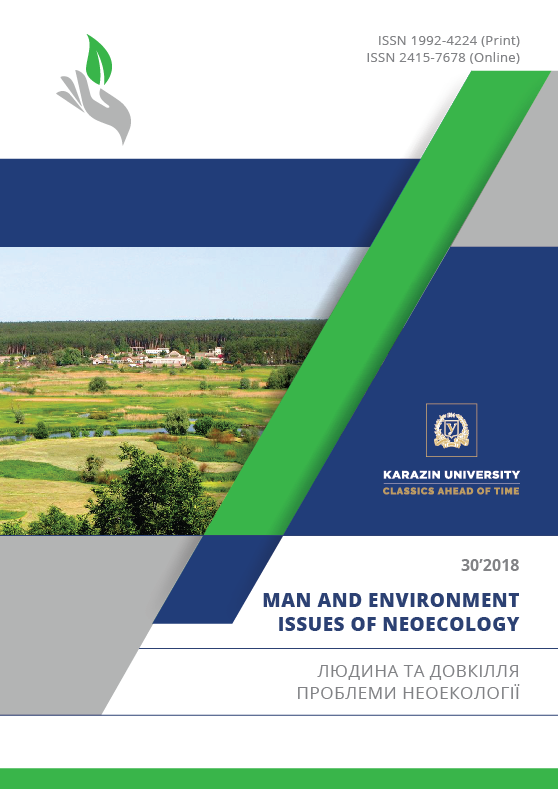Оцінка екологічних ризиків від забруднення повітря міст Китаю
Анотація
Проблема забруднення атмосферного повітря міст Китаю відома далеко за його межами. Вона, навіть, поставила під загрозу проведення ХХІХ Олімпійських ігор у 2008 році. Мета роботи: на основі оцінки забруднення атмосферного повітря міст Пекін, Ченду і Санья (КНР) визначити екологічні ризики для населення. Робота виконувалась на основі даних китайської он-лайн платформи «PM2.5 lishishuju» щодо стану забруднення атмосферного повітря міст Китаю. Проведено порівняльну оцінку вмісту забруднюючих речовин у повітрі та розраховано екологічний ризик для населення цих міст. Розрахунок екологічного ризику зроблено у відповідності до методики, яка використовується для оцінки ризику для здоров’я населення, що зазнає впливу хімічних речовин, забруднюючих довкілля при інгаляційному надходженні речовин до організму людини. Обраховано ризик шляхом порівняння фактичного рівня експозиції з безпечним рівнем впливу та визначення коефіцієнту небезпеки впливу речовини. За результатами розрахунків здійснено ранжування речовини, що забруднюють повітря за величиною коефіцієнту небезпеки для визначення найбільш пріоритетних забруднювачів. Результати дослідження показали, що рівень загального ризику для м. Пекін складає 11,6; для м. Ченду – 26,4; для м. Санья – 4,5. В усіх досліджуваних містах загальний рівень неканцерогенного ризику перевищує граничну прийнятну величину – 1. Найбільший внесок у сумарний неканцерогенний ризик вносять такі елементи: у м. Пекін − завислі речовини (PM 2,5) – 40%, у м. Ченду − завислі речовини (PM 2,5) – 73%, у м. Санья - озон (O3) – 52%. Зазначені речовини обумовлюють імовірність розвитку негативних ефектів у різних органах і системах організму людини. Тому необхідно розглядати окрім загального рівня ризику, ще й вплив на критичні органи і системи. Результати дослідження показали, що найбільш уразливими в умовах забруднення атмосферного повітря досліджуваних міст є органи дихання. Найнебезпечніше перевищення спостерігається в м. Ченду – 26,11. Негативний вплив на серцево-судинну систему відбувається в двох містах: Ченду – 2,35 та Пекіні – 2,30; на розвиток людини діапазон значення ризику розвитку неканцерогенних ефектів складає від 2,30 до 2,35 у м. Пекін та м. Ченду, в м.Санья значення ризику не перевищують допустимий рівень.
Завантаження
Посилання
Office of Research and Development National Center for Environmental Assessment. Integrated science assessment for oxides of nitrogen (2016), North Carolina United States. [in English].
Paul N. Cheremisinoff, Richard Alan Young (1977). Air Pollution Control and Design Handbook, 672-673 [in English].
Boulter, P G, Borken-Kleefeld, J and Ntziachristos, L (2013). Urban Air Quality in Europe. Handbook of Environmental Chemistry, 31-54 [in English]
Zhao B. (2013) NOx emissions in China: historical trends and future perspectives. Atmospheric Chemistry and Physics, 69- 97 [in English].
Online map of Nitrogen Dioxyde (NO2) in our atmosphere. (2018). Available at: http://aqicn.org/faq/2017-01-10/nitrogen-dioxyde-no2-in-our-atmosphere/ [in English]
World-wide Air Quality Monitoring Data Coverage (2018). doi: http://aqicn.org/sources/ [in English].
United Framework. (2018). Available at: http://aqicn.org/data-platform/register/ [in English]
Air quality monitoring device & sensors research. (2018). Available at: https://aqicn.org/sensor [in English].
Mikroskopicheskaya ugroza: chasticy PM10 i PM2,5 [Microscopic threat: PM10 and PM2.5 particles.] (2107). Available at: https://www.msulab.ru/knowledge/air/microscopic-threat-particles-pm10-and-pm2%265/ [in Russian].
Rukovodstvo po ocenke riska dlya zdorov'ya naseleniya pri vozdejstvii himicheskih veshchestv, zagryaznyayushchih okruzhayushchuyu sredu [Guidelines for assessing the risk to public health when ex-posed to chemicals that pollute the environment ]. (2004). Federal'nyj centr Gossanehpidnadzora Minzdrava Rossii,143 [in Russian].
Air Pollution in Asia: Real-time Air Quality Index Visual Map (2017). Available at: http://aqicn.org/map/
Klіmat m. Pekіna. (2017). Available at: http://bj.weather.com.cn [in Ukrainian].
Klіmat m. Chendu (2017). Available at: http://www.weatherbase.com/weather/ weather.php3?s=49265&refer=&cityname=Chengdu-China [in Ukrainian].
Zagryaznenie vozduha v Pekine v rezhime real'nogo vremeni. Indeks kachestva vozduha (AKI). [Air pollu-tion in Beijing in real time. Air quality index (AQI) ]. (2017). Available at: http://aqicn.org/city/beijing/ru/ [in Russian].
Zagryaznenie vozduha v Chendu v rezhime real'nogo vremeni. Indeks kachestva vozduha (AKI).[ Chengdu Air Pollution Real-Time Air Quality Index (AQI)].(2017). Available at: http://aqicn.org/city/chengdu/ru/ [in Russian].
Klіmat m. San'ya (KNR). (2017). doi: http://www.hnszw.org.cn/data/news/2015/02/76945/ [in Ukrainian].
Zagryaznenie vozduha v San'ya v rezhime real'nogo vremeni. Indeks kachestva vozduha (AKI). (2017). Available at: http://aqicn.org/city/sanya/ru/ [in Russian].
Kіots'kij protokol. [Kyoto Protocol ].(1998). Available at: https://unfccc.int/resource/docs/convkp/kprus.pdf [in Ukrainian].
Maksimenko N. V. (2012) Environmental management activity textbook for students of higher education establishments, Kharkiv, Ukraine, 336 [in Ukrainian].
Автори, які публікуються у цьому журналі, погоджуються з наступними умовами:
- Автори залишають за собою право на авторство своєї роботи та передають журналу право першої публікації цієї роботи на умовах ліцензії Creative Commons Attribution License 4.0 International (CC BY 4.0), котра дозволяє іншим особам вільно розповсюджувати опубліковану роботу з обов'язковим посиланням на авторів оригінальної роботи та першу публікацію роботи у цьому журналі.
- Автори мають право укладати самостійні додаткові угоди щодо неексклюзивного розповсюдження роботи у тому вигляді, в якому вона була опублікована цим журналом (наприклад, розміщувати роботу в електронному сховищі установи або публікувати у складі монографії), за умови збереження посилання на першу публікацію роботи у цьому журналі.
- Політика журналу дозволяє і заохочує розміщення авторами в мережі Інтернет (наприклад, у сховищах установ або на особистих веб-сайтах) рукопису роботи, як до подання цього рукопису до редакції, так і під час його редакційного опрацювання, оскільки це сприяє виникненню продуктивної наукової дискусії та позитивно позначається на оперативності та динаміці цитування опублікованої роботи (див. The Effect of Open Access).





